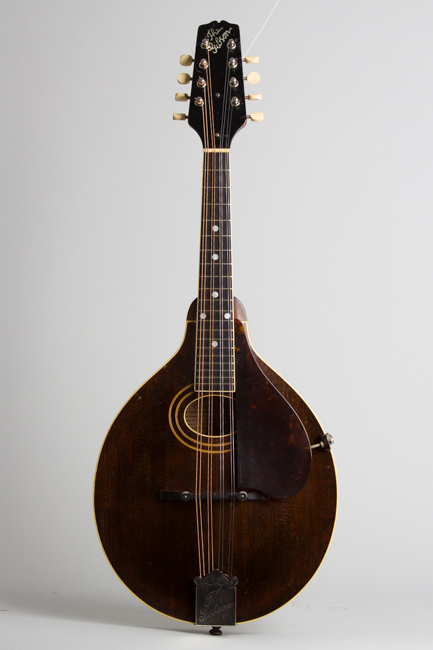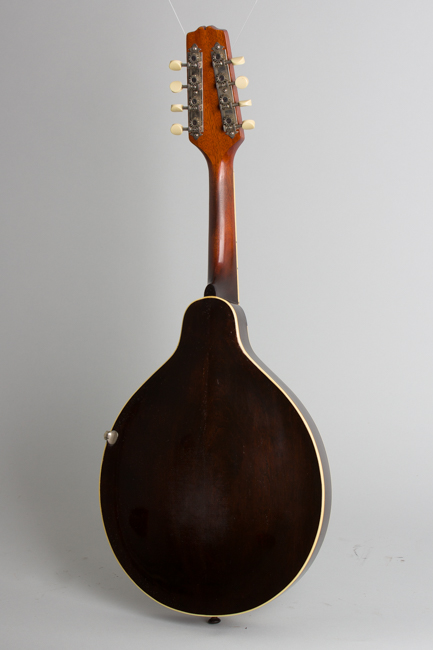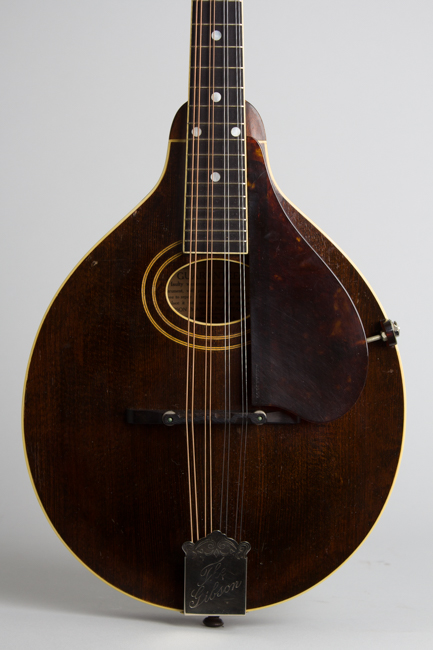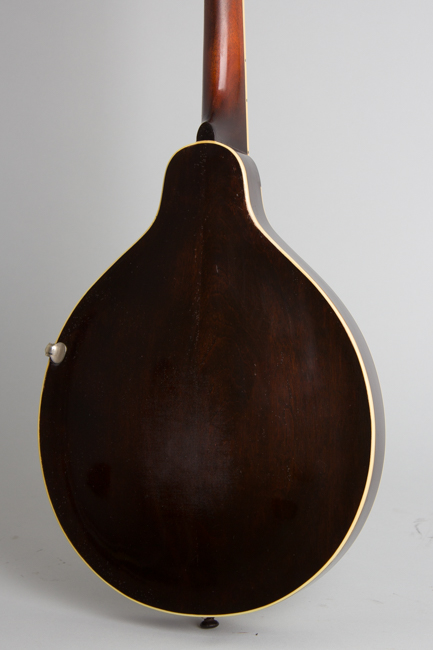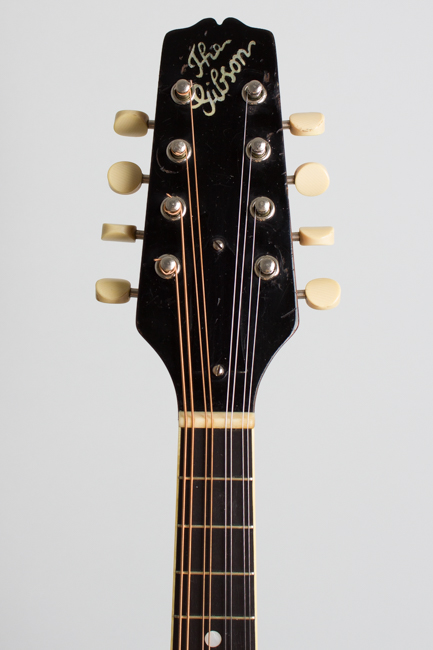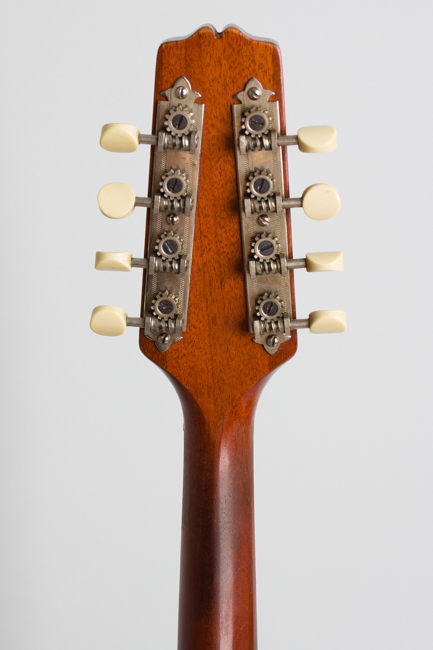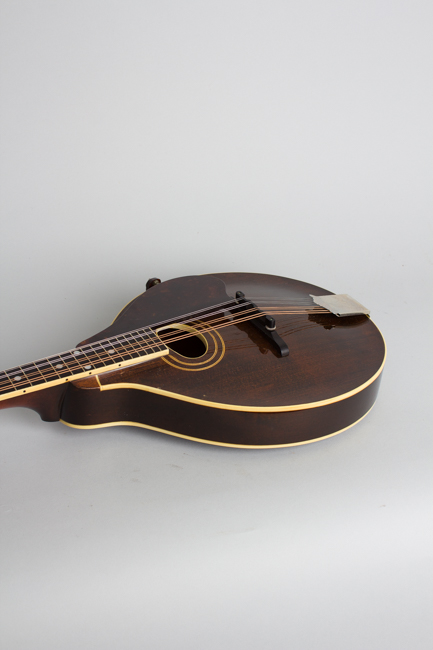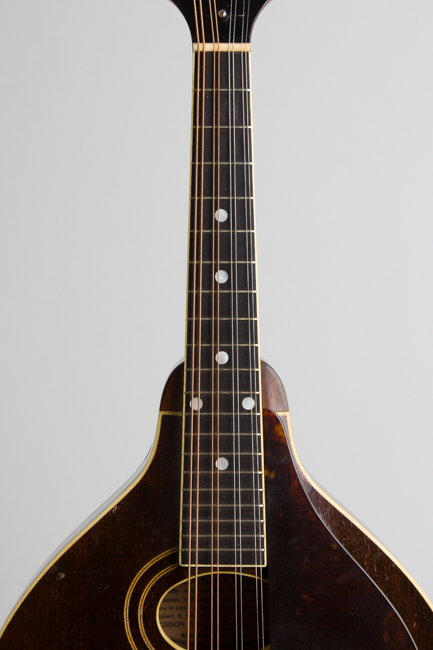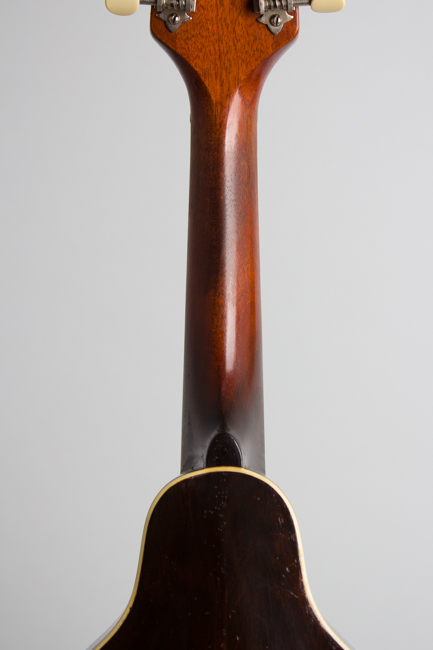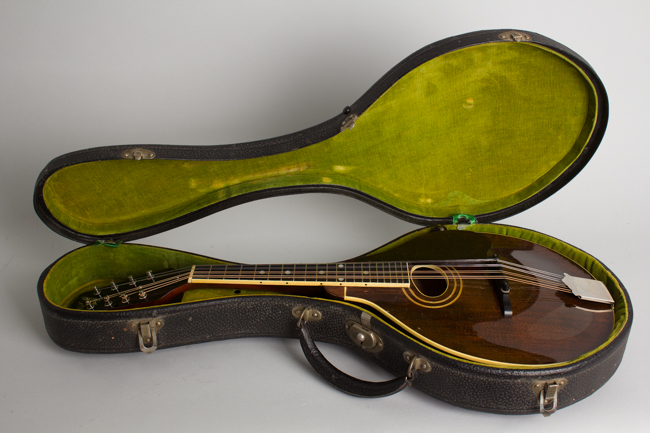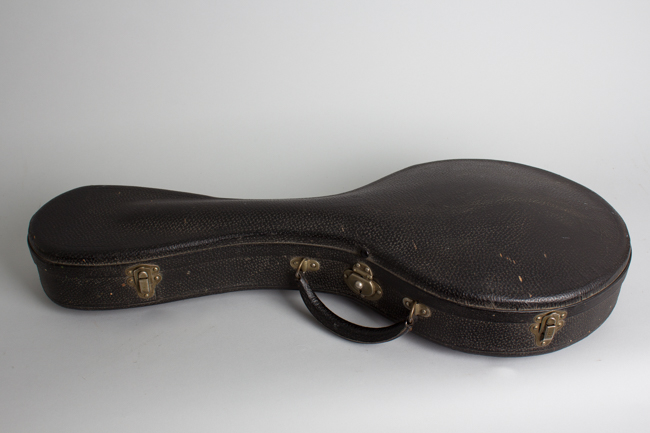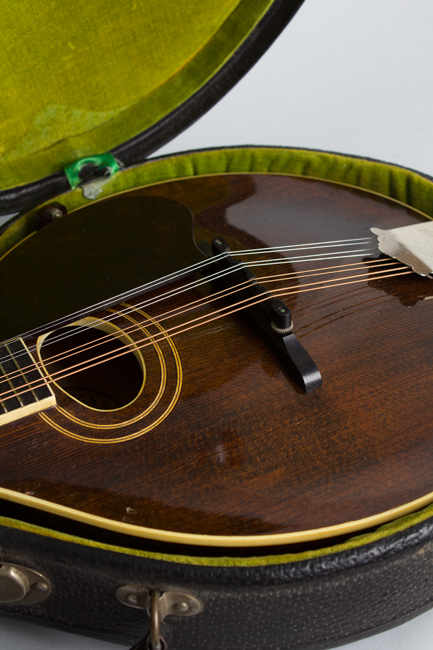Gibson A-2 Snakehead Carved Top Mandolin (1923)
This item has been sold.
Item # 10646
Prices subject to change without notice.
Gibson A-2 Snakehead Model Carved Top Mandolin (1923), made in Kalamazoo, Michigan, serial # 73968, natural top, dark back and sides finish, birch back and sides, spruce top; mahogany neck with ebony fingerboard, original black hard shell case.
this is a really great-playing and sounding original Style A-2 mandolin from late 1923, just about the peak of the "Loar Era" at Gibson. The instruments of this time are generally considered the best-sounding round hole "A"-style mandolins ever made, and this one certainly bears this out. This is a fine example of Gibson's craftsmanship at the apex of the mandolin era, just before the company's focus shifted to banjos and then guitars. These "Snakehead" instruments are revered for their unmatched tone and projection and have all the most advanced features of the era including the adjustable truss rod, raised adjustable bridge, and slim neck profile.
The A-2 was a midline mandolin in the line listed for $65 in late 1923. It is fairly rare compared to the less expensive Style A and A-Junior models, which sold mostly to students. This A-2 was made just as the model was being replaced by the whimsically named "A-2z" model, which was just slightly fancier. It may be from the last batch of A-2's built as the first A-2z's appear just a few batches of factory order numbers along at the end of 1923
This mandolin has an interesting mix of older and newer features, with the late 1910s style "Sheraton Brown" top finish top combined with the new "snakehead" headstock, thinner neck, adjustable truss rod and height adjustable bridge that characterize the improved Loar era instruments. It also mounts an early example of the Waverly tuners Gibson was just switching to. The top, back and fingerboard are single-bound. While the sharply angled "The Gibson" logo seems to barely fit on the small headstock face.
The original Varnish finish has a layer of clear lacquer on top, something Gibson was just starting to use at the time and everything appears to be factory work. The top has thin, double-inlaid wood soundhole ring and a bound edge. The original tortoise celluloid pickguard is fully intact and is held with the earlier-style edge clamp, but mounted to the shaft of the newer, simpler screw bracket.
These distinctive Loar-era A mandolins have become ever more sought-after by discerning players. Lloyd Loar's tenure as acoustic engineer at Gibson has become so mythical that sometimes separating fact from fiction is difficult. The mandolin family instruments made during this period are the most perfectly realized in Gibson's history, showing the influence of a master player on design and execution. Other Gibson employees (especially Thaddeus McHugh and Lewis A. Williams) actually engineered many of the technical improvements of the early 1920s and all Gibson mandolin family instruments were refined at the time. This is a wonderful example of the improvements that made these the best instruments of their type, then and arguably now.
Overall length is 25 7/8 in. (65.7 cm.), 10 1/16 in. (25.6 cm.) width, and 1 13/16 in. (4.6 cm.) in depth, measured at side of rim. Scale length is 13 7/8 in. (352 mm.). Width of nut is 1 1/8 in. (29 mm.).
This is a lovely example overall of this rare and interesting transitional Gibson "A" model, showing some play time but no major wear or repair over the last 99 years. A resealed back/side seam (or possibly just binding pull) off the bass side neck block is the only visible repair. Areas of the finish have been polished out somewhat over time, most heavily in that area. The lacquer/varnish mix is visible under UV light inspection. The only really notable flaw is a decent sized area on the back where the finish reacted to the case lining at some point (usually a result of heat and/or moisture) and a less noticeable similar spot on the lower rim.
There are some pick scratches, some finish rubs and dings overall, with a couple of chips to the headstock face. The back of the neck is worn down to the wood for part of its length. All hardware is original and in excellent condition. The original frets have been crowned down a bit but still play fine. Really this mandolin shows not too much wear for almost a century on Earth. As a player this is simply a wonderful instrument with a very powerfully bright but well-modulated sound. It includes a nice original green-lined HSC. Excellent - Condition.
this is a really great-playing and sounding original Style A-2 mandolin from late 1923, just about the peak of the "Loar Era" at Gibson. The instruments of this time are generally considered the best-sounding round hole "A"-style mandolins ever made, and this one certainly bears this out. This is a fine example of Gibson's craftsmanship at the apex of the mandolin era, just before the company's focus shifted to banjos and then guitars. These "Snakehead" instruments are revered for their unmatched tone and projection and have all the most advanced features of the era including the adjustable truss rod, raised adjustable bridge, and slim neck profile.
The A-2 was a midline mandolin in the line listed for $65 in late 1923. It is fairly rare compared to the less expensive Style A and A-Junior models, which sold mostly to students. This A-2 was made just as the model was being replaced by the whimsically named "A-2z" model, which was just slightly fancier. It may be from the last batch of A-2's built as the first A-2z's appear just a few batches of factory order numbers along at the end of 1923
This mandolin has an interesting mix of older and newer features, with the late 1910s style "Sheraton Brown" top finish top combined with the new "snakehead" headstock, thinner neck, adjustable truss rod and height adjustable bridge that characterize the improved Loar era instruments. It also mounts an early example of the Waverly tuners Gibson was just switching to. The top, back and fingerboard are single-bound. While the sharply angled "The Gibson" logo seems to barely fit on the small headstock face.
The original Varnish finish has a layer of clear lacquer on top, something Gibson was just starting to use at the time and everything appears to be factory work. The top has thin, double-inlaid wood soundhole ring and a bound edge. The original tortoise celluloid pickguard is fully intact and is held with the earlier-style edge clamp, but mounted to the shaft of the newer, simpler screw bracket.
These distinctive Loar-era A mandolins have become ever more sought-after by discerning players. Lloyd Loar's tenure as acoustic engineer at Gibson has become so mythical that sometimes separating fact from fiction is difficult. The mandolin family instruments made during this period are the most perfectly realized in Gibson's history, showing the influence of a master player on design and execution. Other Gibson employees (especially Thaddeus McHugh and Lewis A. Williams) actually engineered many of the technical improvements of the early 1920s and all Gibson mandolin family instruments were refined at the time. This is a wonderful example of the improvements that made these the best instruments of their type, then and arguably now.
Overall length is 25 7/8 in. (65.7 cm.), 10 1/16 in. (25.6 cm.) width, and 1 13/16 in. (4.6 cm.) in depth, measured at side of rim. Scale length is 13 7/8 in. (352 mm.). Width of nut is 1 1/8 in. (29 mm.).
This is a lovely example overall of this rare and interesting transitional Gibson "A" model, showing some play time but no major wear or repair over the last 99 years. A resealed back/side seam (or possibly just binding pull) off the bass side neck block is the only visible repair. Areas of the finish have been polished out somewhat over time, most heavily in that area. The lacquer/varnish mix is visible under UV light inspection. The only really notable flaw is a decent sized area on the back where the finish reacted to the case lining at some point (usually a result of heat and/or moisture) and a less noticeable similar spot on the lower rim.
There are some pick scratches, some finish rubs and dings overall, with a couple of chips to the headstock face. The back of the neck is worn down to the wood for part of its length. All hardware is original and in excellent condition. The original frets have been crowned down a bit but still play fine. Really this mandolin shows not too much wear for almost a century on Earth. As a player this is simply a wonderful instrument with a very powerfully bright but well-modulated sound. It includes a nice original green-lined HSC. Excellent - Condition.
